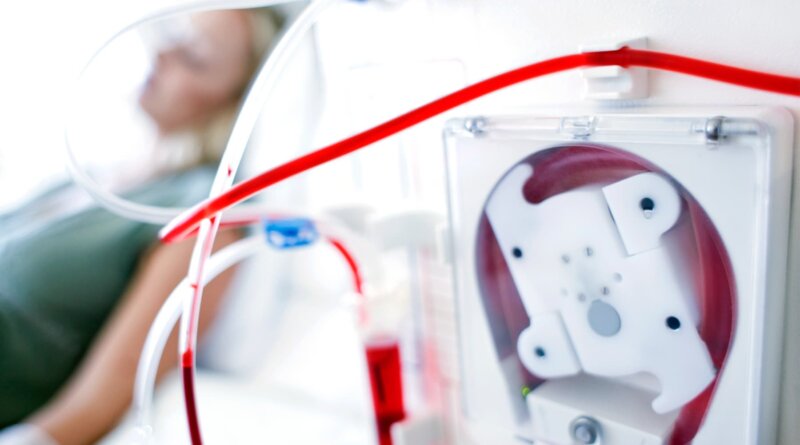My Dialysis Machine Works as My Kidneys, for Now
Claudia Morhibi, 51, has lived with autosomal dominant polycystic kidney disease (ADPKD) for over 30 years. She is in stage IV kidney disease, and her doctor has recently begun to talk to her about preparing for dialysis.
“My mom went through dialysis for 5 years while she was on the wait list for a kidney transplant,” says Morhibi. “It was not a good experience — it left her often feeling nauseous and fatigued. But when it gets to that point, you have no choice.”
For many people, it’s a temporary option until a kidney transplant becomes available, “but they may have to do dialysis while they are on a wait list, which is usually about 5 years,” says Jaime Uribarri, MD, director of the Mount Sinai Hospital home dialysis program.
How Do I Prepare for It?
Most kidney specialists recommend that you start dialysis when 85%-90% of kidney function is gone and/or your glomerular filtration rate (GFR) falls below 15. “By the time a patient’s GFR is at 30, I am talking to them about dialysis and encouraging them to get on a kidney transplant list,” says Uribarri. Since ADPKD progresses relatively slowly, it gives patients some time to prepare, he notes.
When your GFR gets down to around 20, Uribarri recommends that you talk to your doctor about placing a fistula. In this surgery, an artery is joined to a nearby vein under your skin to make a bigger blood vessel. This creates an access point for the dialysis machine. “We like to do this 2 to 3 months before the first session of dialysis, since it can take several weeks for the fistula to heal and become sturdy enough to withstand thrice-weekly dialysis treatments,” he explains.
If you don’t have a vein large enough for a fistula, your doctor can create an artificial vein and install it surgically. If you need to begin dialysis right away, your doctor can insert a dialysis catheter in your neck or chest as a short-term solution. But, if possible, you want to avoid this method. “I had to change out my catheter four times over a 5-month period because it wasn’t working properly,” says Dawn Cleeton-Lewis, a 37-year-old fraud investigator in Fort Worth, TX, who began dialysis in March after she went into kidney failure.
What Should I Expect?
Most people who go on hemodialysis end up doing in-center hemodialysis at a hospital or dialysis center, says Uribarri. This is when a machine removes blood from your body, filters it through a dialyzer (artificial kidney), and returns the cleaned blood to your body. It takes anywhere from 3 to 5 hours and is done three times a week. “I generally spend the first hour on my phone, then I sleep the rest of the time because I feel so exhausted,” says Cleeton-Lewis.
You may have side effects during or after hemodialysis. These include:
- Low blood pressure
- Nausea
- Dizziness or fainting
- Headaches
- Itchy skin
- Muscle cramps
- Restless legs syndrome
Since in-center hemodialysis takes a lot of time, you may also need to speak to your employer about changing your work hours. Cleeton-Lewis has it down to a science. “The 3 days a week I do dialysis, I go from 6 a.m. to 10 a.m., then I’m at my desk doing work from 10:30 a.m. to 7 p.m.,” she says. “Some days, especially at the beginning when I was just getting used to dialysis, I couldn’t make it that long, so I would lie down for a nap in the midafternoon for about an hour.”
Another option is home hemodialysis. Since it’s easier to fit treatments into your daily schedule, you may be more likely to do it, says Uribarri. There’s some evidence that home hemodialysis allows you to take less medication to control complications of kidney disease like high blood pressure or anemia, have fewer side effects, and have a better quality of life overall. But you will need training so you can safely do it at home. There are three main types:
- Conventional home hemodialysis: You do this three times a week for 3 to 4 hours at a time.
- Short daily home hemodialysis: This is done five to seven times a week for about 2 hours each session. Since you’re doing it more frequently, less fluid needs to be removed. This reduces side effects.
- Nocturnal home hemodialysis: These treatments are done while you sleep most nights of the week for 6 to 8 hours, which can result in more waste removal.
Very rarely, you may get complications from hemodialysis, says Uribarri. These include an infected AV fistula or graft, or a blockage from scar tissue. The dialysis needle can also fall out of your arm, but an alarm will go off to alert you or medical staff to the problem.
What Changes Will I Need to Make?
Besides the time commitment of doing dialysis, whether it’s in a center or at home, you’ll need to make other changes to your lifestyle. These include:
Limit salt intake. This may help control your blood pressure. It may also keep you from retaining fluids between dialysis sessions.
Eat more protein. People on dialysis need about 8-10 ounces of high-protein food like meat, fish, poultry, or eggs every day. While nuts, seeds, and legumes also have protein, you’ll need to limit them because they are high in potassium and phosphorus.
Avoid whole-grain foods. Whole-wheat bread, bran cereal, and brown rice are high in phosphorus, which is bad for your kidneys in high amounts.
Be careful with dairy. Foods like milk, yogurt, and cheese are high in phosphorus. Limit them, or if you do eat them, take a phosphate binder with that meal.
Focus on certain fruits and veggies. You’ll also need to limit potassium if you have advanced kidney disease. Apples, berries, cherries, grapes, cruciferous veggies, carrots, and green beans are all good choices.
Although she hopefully won’t have to go in for dialysis for at least another year, Morhibi is planning ahead. “I saw my mother go through it for so many years, I know what to expect,” she says. “Although it was hard on her body, I want to stay positive and view it as just another stage in my life until I’m able to get a kidney transplant.”




